Analysis of Pressure and Flow Rate Effects in Reverse Osmosis Membrane
VerifiedAdded on 2021/06/15
|14
|3682
|19
Report
AI Summary
This report delves into the fluid mechanics of reverse osmosis (RO) membranes, specifically examining the impact of pressure and flow rate variations on their functionality. The study explores how changes in pressure influence salt rejection, recovery rates, and the concentration of minerals in the permeate water. It highlights the direct relationship between pressure and flow rate, emphasizing that increased pressure generally enhances salt rejection and recovery but may also negatively affect the long-term durability of the membrane due to increased stress and reduced porosity. The analysis covers the effects of pressure on osmotic pressure, and the significance of flow rate in determining the amount of molecules passing through the membrane. The report concludes that while high pressure is essential for effective RO operation, a balance must be maintained to ensure both efficient purification and prolonged membrane lifespan. It also discusses how increased pressure can improve the removal of salts and fluoride, but potentially reduce the membrane's durability over time. The report underscores the importance of optimizing pressure and flow rate to maximize the effectiveness and longevity of RO systems.
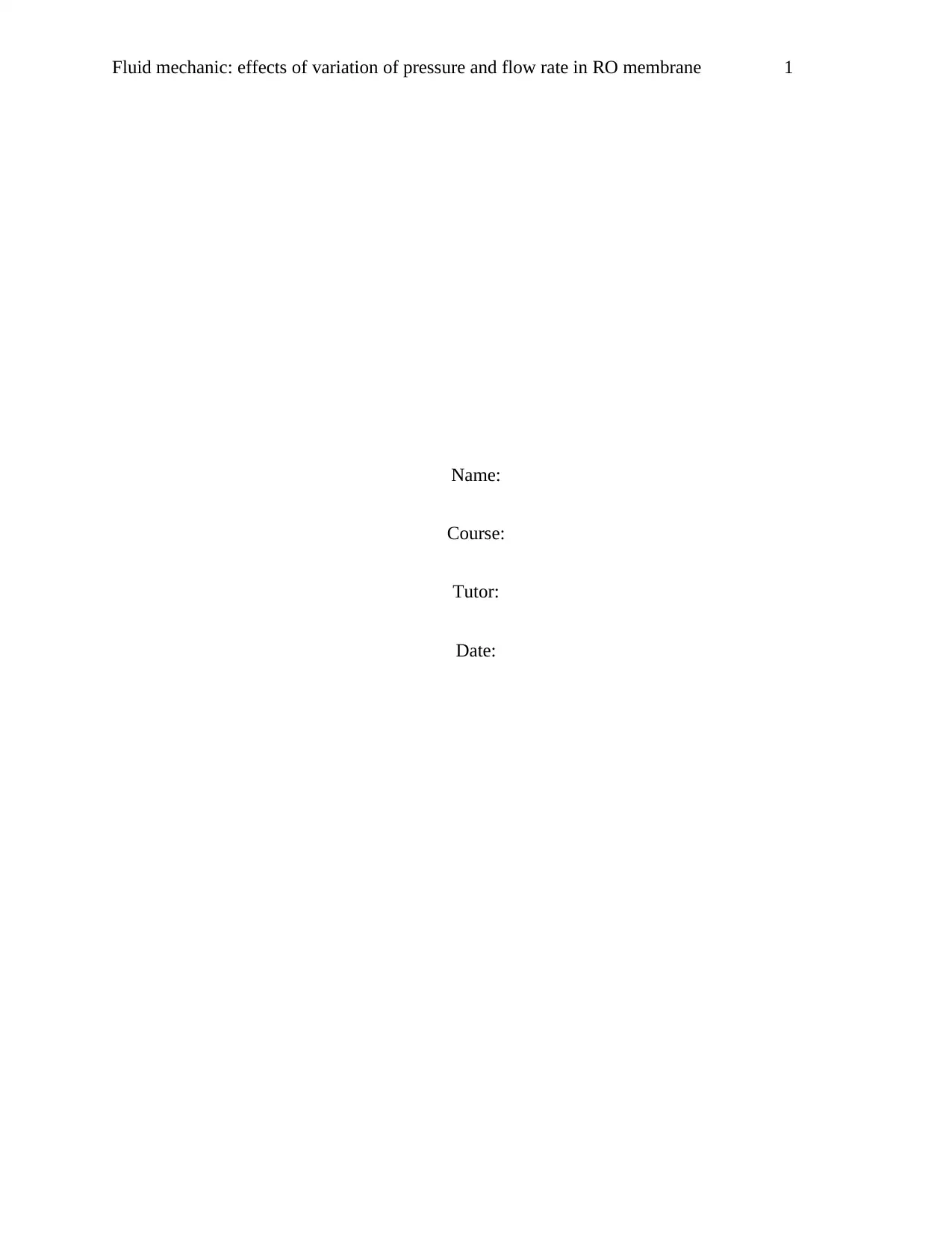
Fluid mechanic: effects of variation of pressure and flow rate in RO membrane 1
Name:
Course:
Tutor:
Date:
Name:
Course:
Tutor:
Date:
Paraphrase This Document
Need a fresh take? Get an instant paraphrase of this document with our AI Paraphraser
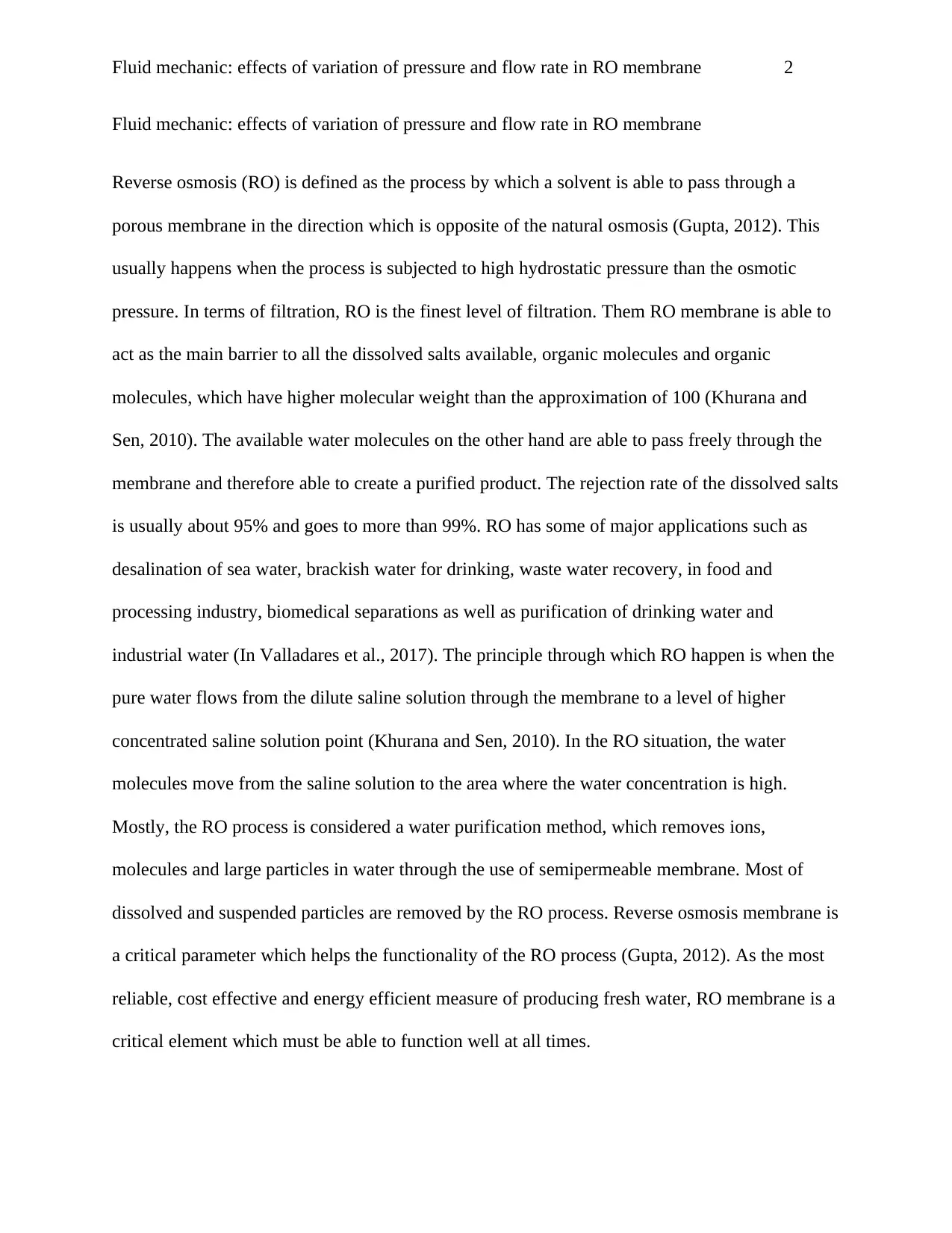
Fluid mechanic: effects of variation of pressure and flow rate in RO membrane 2
Fluid mechanic: effects of variation of pressure and flow rate in RO membrane
Reverse osmosis (RO) is defined as the process by which a solvent is able to pass through a
porous membrane in the direction which is opposite of the natural osmosis (Gupta, 2012). This
usually happens when the process is subjected to high hydrostatic pressure than the osmotic
pressure. In terms of filtration, RO is the finest level of filtration. Them RO membrane is able to
act as the main barrier to all the dissolved salts available, organic molecules and organic
molecules, which have higher molecular weight than the approximation of 100 (Khurana and
Sen, 2010). The available water molecules on the other hand are able to pass freely through the
membrane and therefore able to create a purified product. The rejection rate of the dissolved salts
is usually about 95% and goes to more than 99%. RO has some of major applications such as
desalination of sea water, brackish water for drinking, waste water recovery, in food and
processing industry, biomedical separations as well as purification of drinking water and
industrial water (In Valladares et al., 2017). The principle through which RO happen is when the
pure water flows from the dilute saline solution through the membrane to a level of higher
concentrated saline solution point (Khurana and Sen, 2010). In the RO situation, the water
molecules move from the saline solution to the area where the water concentration is high.
Mostly, the RO process is considered a water purification method, which removes ions,
molecules and large particles in water through the use of semipermeable membrane. Most of
dissolved and suspended particles are removed by the RO process. Reverse osmosis membrane is
a critical parameter which helps the functionality of the RO process (Gupta, 2012). As the most
reliable, cost effective and energy efficient measure of producing fresh water, RO membrane is a
critical element which must be able to function well at all times.
Fluid mechanic: effects of variation of pressure and flow rate in RO membrane
Reverse osmosis (RO) is defined as the process by which a solvent is able to pass through a
porous membrane in the direction which is opposite of the natural osmosis (Gupta, 2012). This
usually happens when the process is subjected to high hydrostatic pressure than the osmotic
pressure. In terms of filtration, RO is the finest level of filtration. Them RO membrane is able to
act as the main barrier to all the dissolved salts available, organic molecules and organic
molecules, which have higher molecular weight than the approximation of 100 (Khurana and
Sen, 2010). The available water molecules on the other hand are able to pass freely through the
membrane and therefore able to create a purified product. The rejection rate of the dissolved salts
is usually about 95% and goes to more than 99%. RO has some of major applications such as
desalination of sea water, brackish water for drinking, waste water recovery, in food and
processing industry, biomedical separations as well as purification of drinking water and
industrial water (In Valladares et al., 2017). The principle through which RO happen is when the
pure water flows from the dilute saline solution through the membrane to a level of higher
concentrated saline solution point (Khurana and Sen, 2010). In the RO situation, the water
molecules move from the saline solution to the area where the water concentration is high.
Mostly, the RO process is considered a water purification method, which removes ions,
molecules and large particles in water through the use of semipermeable membrane. Most of
dissolved and suspended particles are removed by the RO process. Reverse osmosis membrane is
a critical parameter which helps the functionality of the RO process (Gupta, 2012). As the most
reliable, cost effective and energy efficient measure of producing fresh water, RO membrane is a
critical element which must be able to function well at all times.
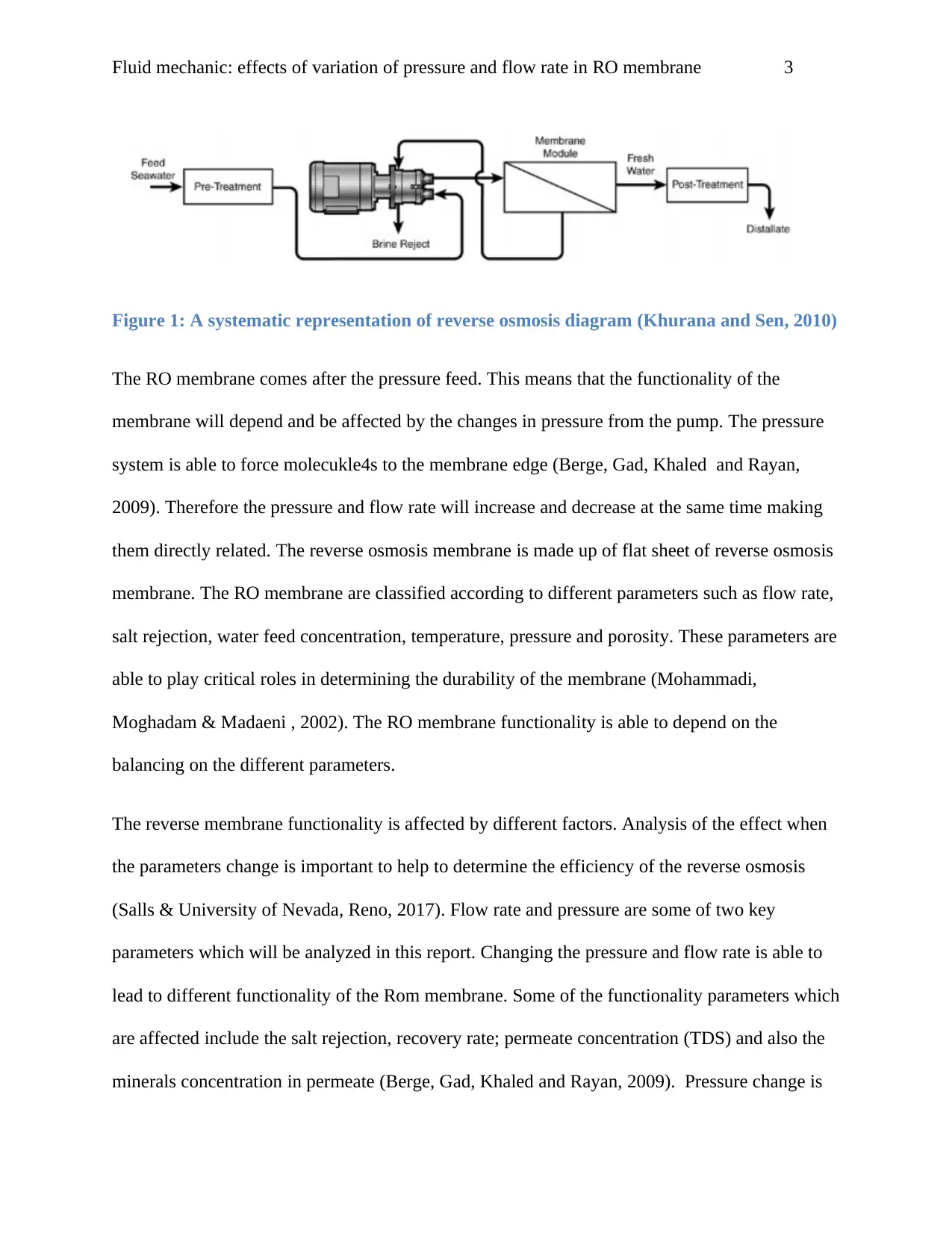
Fluid mechanic: effects of variation of pressure and flow rate in RO membrane 3
Figure 1: A systematic representation of reverse osmosis diagram (Khurana and Sen, 2010)
The RO membrane comes after the pressure feed. This means that the functionality of the
membrane will depend and be affected by the changes in pressure from the pump. The pressure
system is able to force molecukle4s to the membrane edge (Berge, Gad, Khaled and Rayan,
2009). Therefore the pressure and flow rate will increase and decrease at the same time making
them directly related. The reverse osmosis membrane is made up of flat sheet of reverse osmosis
membrane. The RO membrane are classified according to different parameters such as flow rate,
salt rejection, water feed concentration, temperature, pressure and porosity. These parameters are
able to play critical roles in determining the durability of the membrane (Mohammadi,
Moghadam & Madaeni , 2002). The RO membrane functionality is able to depend on the
balancing on the different parameters.
The reverse membrane functionality is affected by different factors. Analysis of the effect when
the parameters change is important to help to determine the efficiency of the reverse osmosis
(Salls & University of Nevada, Reno, 2017). Flow rate and pressure are some of two key
parameters which will be analyzed in this report. Changing the pressure and flow rate is able to
lead to different functionality of the Rom membrane. Some of the functionality parameters which
are affected include the salt rejection, recovery rate; permeate concentration (TDS) and also the
minerals concentration in permeate (Berge, Gad, Khaled and Rayan, 2009). Pressure change is
Figure 1: A systematic representation of reverse osmosis diagram (Khurana and Sen, 2010)
The RO membrane comes after the pressure feed. This means that the functionality of the
membrane will depend and be affected by the changes in pressure from the pump. The pressure
system is able to force molecukle4s to the membrane edge (Berge, Gad, Khaled and Rayan,
2009). Therefore the pressure and flow rate will increase and decrease at the same time making
them directly related. The reverse osmosis membrane is made up of flat sheet of reverse osmosis
membrane. The RO membrane are classified according to different parameters such as flow rate,
salt rejection, water feed concentration, temperature, pressure and porosity. These parameters are
able to play critical roles in determining the durability of the membrane (Mohammadi,
Moghadam & Madaeni , 2002). The RO membrane functionality is able to depend on the
balancing on the different parameters.
The reverse membrane functionality is affected by different factors. Analysis of the effect when
the parameters change is important to help to determine the efficiency of the reverse osmosis
(Salls & University of Nevada, Reno, 2017). Flow rate and pressure are some of two key
parameters which will be analyzed in this report. Changing the pressure and flow rate is able to
lead to different functionality of the Rom membrane. Some of the functionality parameters which
are affected include the salt rejection, recovery rate; permeate concentration (TDS) and also the
minerals concentration in permeate (Berge, Gad, Khaled and Rayan, 2009). Pressure change is
⊘ This is a preview!⊘
Do you want full access?
Subscribe today to unlock all pages.

Trusted by 1+ million students worldwide
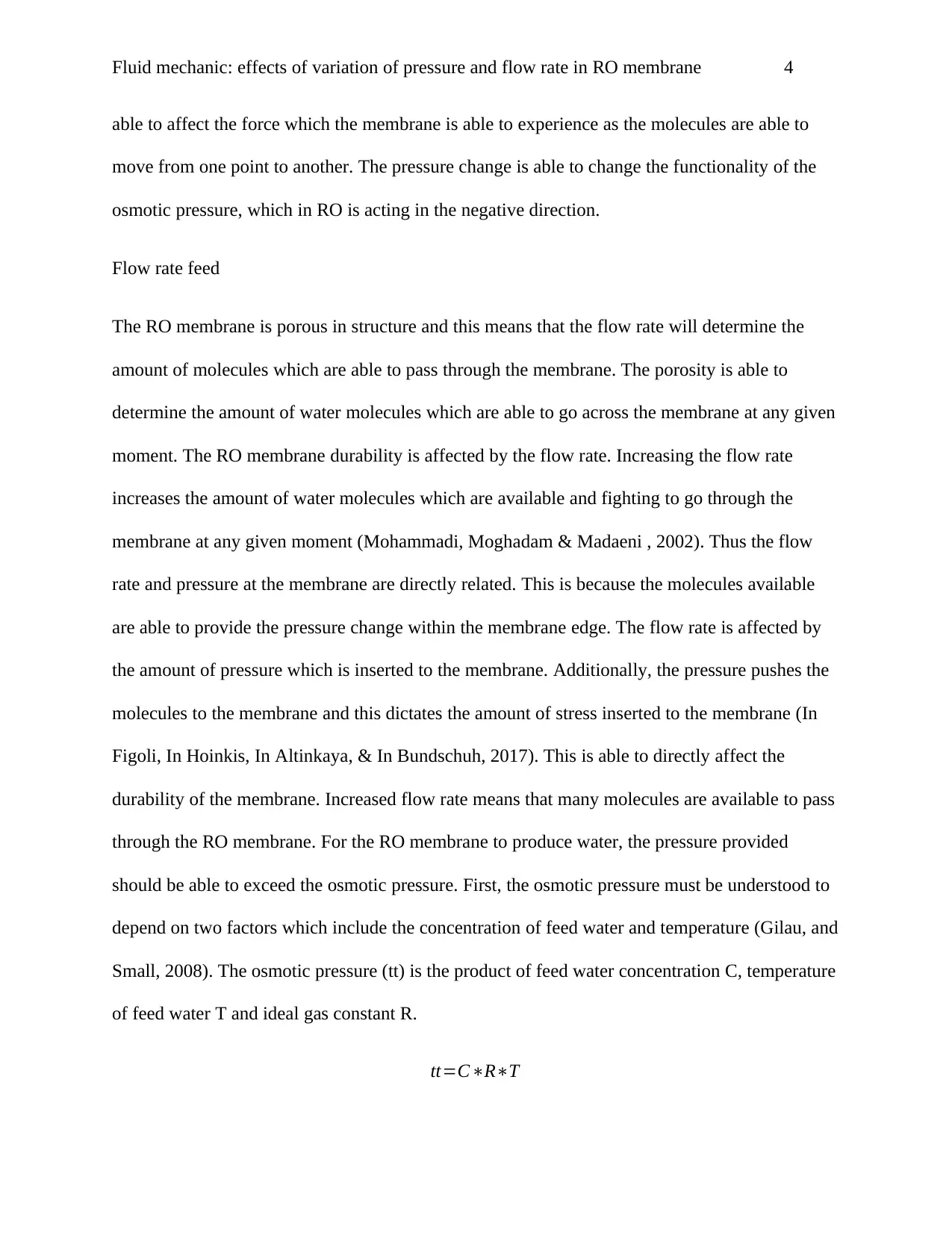
Fluid mechanic: effects of variation of pressure and flow rate in RO membrane 4
able to affect the force which the membrane is able to experience as the molecules are able to
move from one point to another. The pressure change is able to change the functionality of the
osmotic pressure, which in RO is acting in the negative direction.
Flow rate feed
The RO membrane is porous in structure and this means that the flow rate will determine the
amount of molecules which are able to pass through the membrane. The porosity is able to
determine the amount of water molecules which are able to go across the membrane at any given
moment. The RO membrane durability is affected by the flow rate. Increasing the flow rate
increases the amount of water molecules which are available and fighting to go through the
membrane at any given moment (Mohammadi, Moghadam & Madaeni , 2002). Thus the flow
rate and pressure at the membrane are directly related. This is because the molecules available
are able to provide the pressure change within the membrane edge. The flow rate is affected by
the amount of pressure which is inserted to the membrane. Additionally, the pressure pushes the
molecules to the membrane and this dictates the amount of stress inserted to the membrane (In
Figoli, In Hoinkis, In Altinkaya, & In Bundschuh, 2017). This is able to directly affect the
durability of the membrane. Increased flow rate means that many molecules are available to pass
through the RO membrane. For the RO membrane to produce water, the pressure provided
should be able to exceed the osmotic pressure. First, the osmotic pressure must be understood to
depend on two factors which include the concentration of feed water and temperature (Gilau, and
Small, 2008). The osmotic pressure (tt) is the product of feed water concentration C, temperature
of feed water T and ideal gas constant R.
tt=C∗R∗T
able to affect the force which the membrane is able to experience as the molecules are able to
move from one point to another. The pressure change is able to change the functionality of the
osmotic pressure, which in RO is acting in the negative direction.
Flow rate feed
The RO membrane is porous in structure and this means that the flow rate will determine the
amount of molecules which are able to pass through the membrane. The porosity is able to
determine the amount of water molecules which are able to go across the membrane at any given
moment. The RO membrane durability is affected by the flow rate. Increasing the flow rate
increases the amount of water molecules which are available and fighting to go through the
membrane at any given moment (Mohammadi, Moghadam & Madaeni , 2002). Thus the flow
rate and pressure at the membrane are directly related. This is because the molecules available
are able to provide the pressure change within the membrane edge. The flow rate is affected by
the amount of pressure which is inserted to the membrane. Additionally, the pressure pushes the
molecules to the membrane and this dictates the amount of stress inserted to the membrane (In
Figoli, In Hoinkis, In Altinkaya, & In Bundschuh, 2017). This is able to directly affect the
durability of the membrane. Increased flow rate means that many molecules are available to pass
through the RO membrane. For the RO membrane to produce water, the pressure provided
should be able to exceed the osmotic pressure. First, the osmotic pressure must be understood to
depend on two factors which include the concentration of feed water and temperature (Gilau, and
Small, 2008). The osmotic pressure (tt) is the product of feed water concentration C, temperature
of feed water T and ideal gas constant R.
tt=C∗R∗T
Paraphrase This Document
Need a fresh take? Get an instant paraphrase of this document with our AI Paraphraser
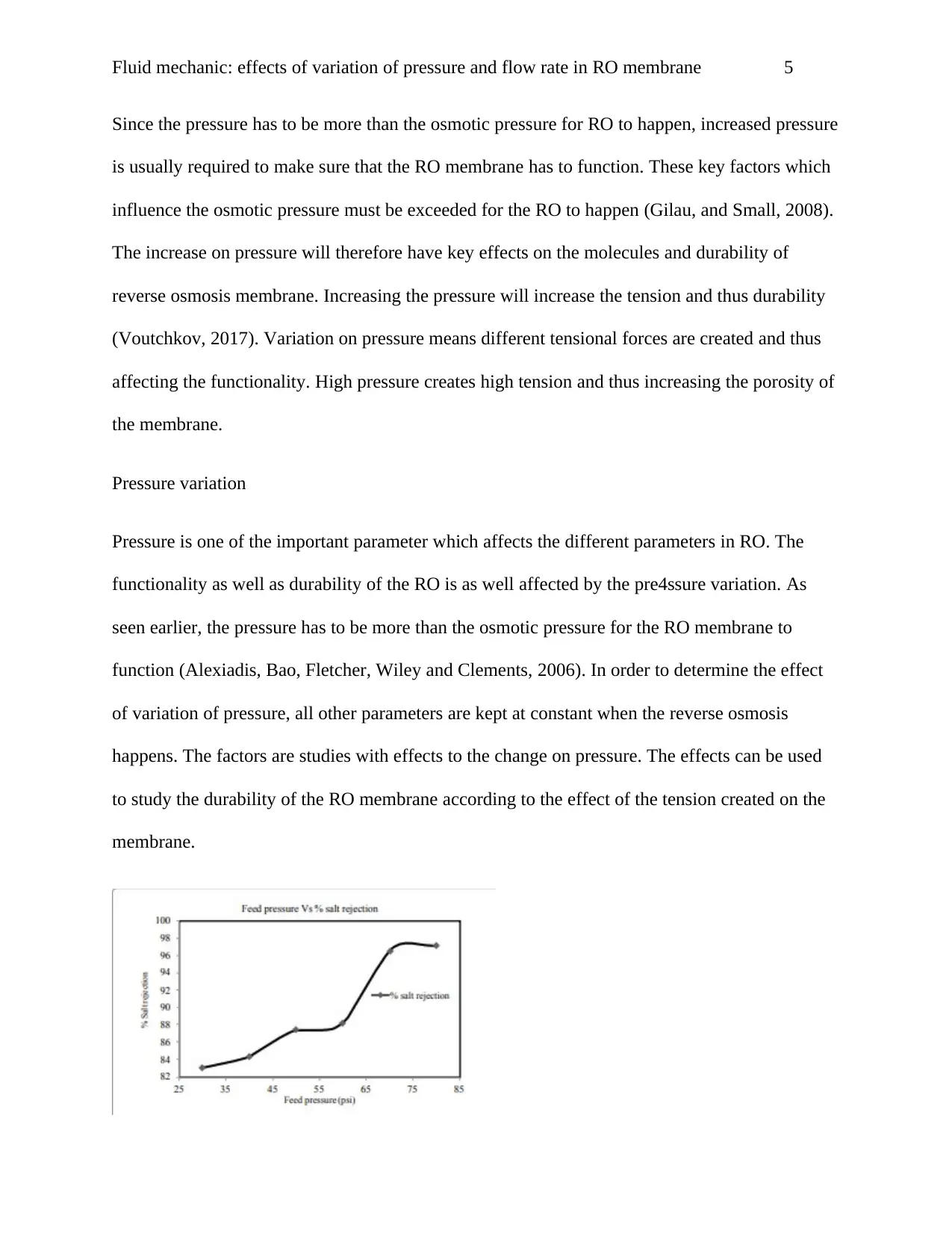
Fluid mechanic: effects of variation of pressure and flow rate in RO membrane 5
Since the pressure has to be more than the osmotic pressure for RO to happen, increased pressure
is usually required to make sure that the RO membrane has to function. These key factors which
influence the osmotic pressure must be exceeded for the RO to happen (Gilau, and Small, 2008).
The increase on pressure will therefore have key effects on the molecules and durability of
reverse osmosis membrane. Increasing the pressure will increase the tension and thus durability
(Voutchkov, 2017). Variation on pressure means different tensional forces are created and thus
affecting the functionality. High pressure creates high tension and thus increasing the porosity of
the membrane.
Pressure variation
Pressure is one of the important parameter which affects the different parameters in RO. The
functionality as well as durability of the RO is as well affected by the pre4ssure variation. As
seen earlier, the pressure has to be more than the osmotic pressure for the RO membrane to
function (Alexiadis, Bao, Fletcher, Wiley and Clements, 2006). In order to determine the effect
of variation of pressure, all other parameters are kept at constant when the reverse osmosis
happens. The factors are studies with effects to the change on pressure. The effects can be used
to study the durability of the RO membrane according to the effect of the tension created on the
membrane.
Since the pressure has to be more than the osmotic pressure for RO to happen, increased pressure
is usually required to make sure that the RO membrane has to function. These key factors which
influence the osmotic pressure must be exceeded for the RO to happen (Gilau, and Small, 2008).
The increase on pressure will therefore have key effects on the molecules and durability of
reverse osmosis membrane. Increasing the pressure will increase the tension and thus durability
(Voutchkov, 2017). Variation on pressure means different tensional forces are created and thus
affecting the functionality. High pressure creates high tension and thus increasing the porosity of
the membrane.
Pressure variation
Pressure is one of the important parameter which affects the different parameters in RO. The
functionality as well as durability of the RO is as well affected by the pre4ssure variation. As
seen earlier, the pressure has to be more than the osmotic pressure for the RO membrane to
function (Alexiadis, Bao, Fletcher, Wiley and Clements, 2006). In order to determine the effect
of variation of pressure, all other parameters are kept at constant when the reverse osmosis
happens. The factors are studies with effects to the change on pressure. The effects can be used
to study the durability of the RO membrane according to the effect of the tension created on the
membrane.
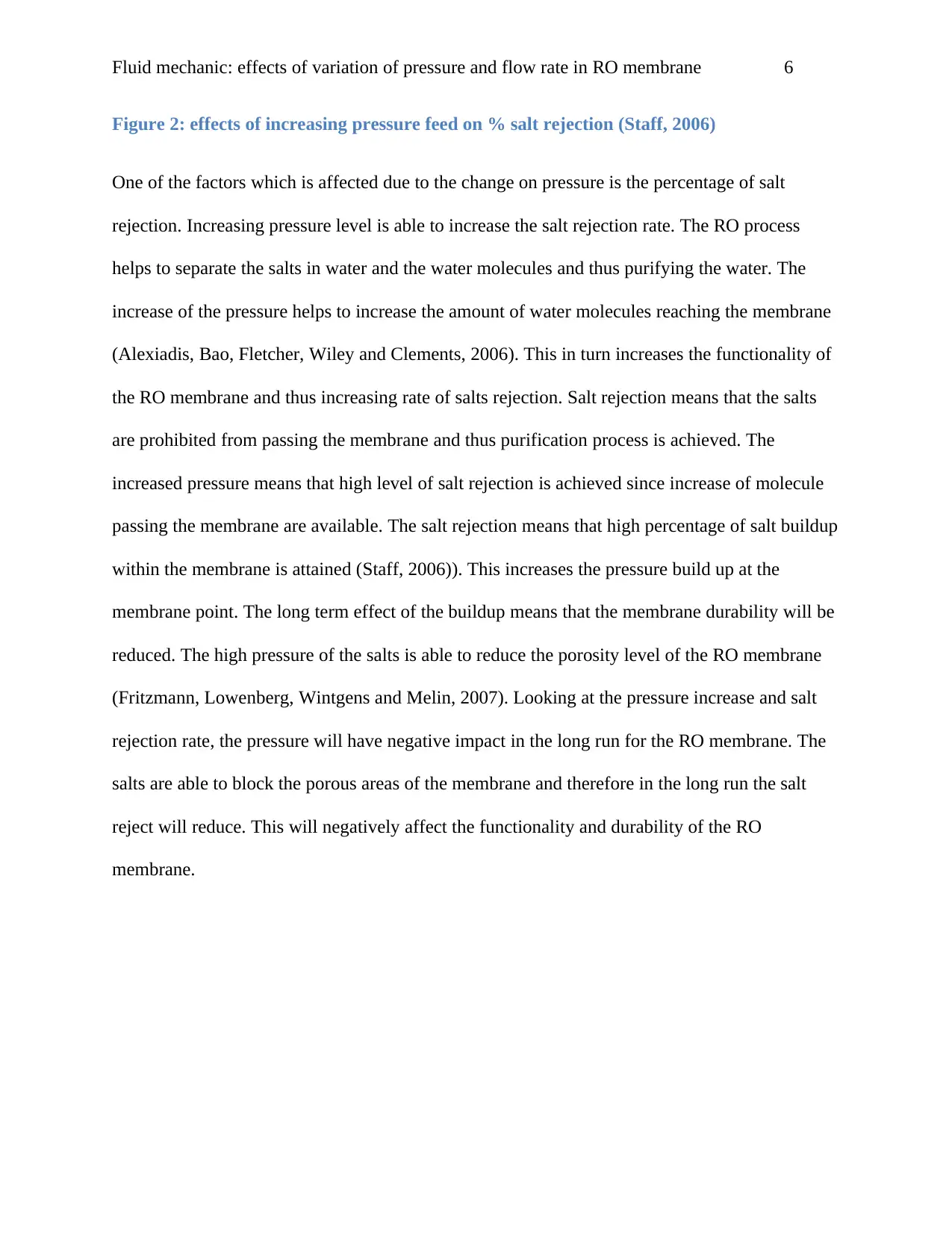
Fluid mechanic: effects of variation of pressure and flow rate in RO membrane 6
Figure 2: effects of increasing pressure feed on % salt rejection (Staff, 2006)
One of the factors which is affected due to the change on pressure is the percentage of salt
rejection. Increasing pressure level is able to increase the salt rejection rate. The RO process
helps to separate the salts in water and the water molecules and thus purifying the water. The
increase of the pressure helps to increase the amount of water molecules reaching the membrane
(Alexiadis, Bao, Fletcher, Wiley and Clements, 2006). This in turn increases the functionality of
the RO membrane and thus increasing rate of salts rejection. Salt rejection means that the salts
are prohibited from passing the membrane and thus purification process is achieved. The
increased pressure means that high level of salt rejection is achieved since increase of molecule
passing the membrane are available. The salt rejection means that high percentage of salt buildup
within the membrane is attained (Staff, 2006)). This increases the pressure build up at the
membrane point. The long term effect of the buildup means that the membrane durability will be
reduced. The high pressure of the salts is able to reduce the porosity level of the RO membrane
(Fritzmann, Lowenberg, Wintgens and Melin, 2007). Looking at the pressure increase and salt
rejection rate, the pressure will have negative impact in the long run for the RO membrane. The
salts are able to block the porous areas of the membrane and therefore in the long run the salt
reject will reduce. This will negatively affect the functionality and durability of the RO
membrane.
Figure 2: effects of increasing pressure feed on % salt rejection (Staff, 2006)
One of the factors which is affected due to the change on pressure is the percentage of salt
rejection. Increasing pressure level is able to increase the salt rejection rate. The RO process
helps to separate the salts in water and the water molecules and thus purifying the water. The
increase of the pressure helps to increase the amount of water molecules reaching the membrane
(Alexiadis, Bao, Fletcher, Wiley and Clements, 2006). This in turn increases the functionality of
the RO membrane and thus increasing rate of salts rejection. Salt rejection means that the salts
are prohibited from passing the membrane and thus purification process is achieved. The
increased pressure means that high level of salt rejection is achieved since increase of molecule
passing the membrane are available. The salt rejection means that high percentage of salt buildup
within the membrane is attained (Staff, 2006)). This increases the pressure build up at the
membrane point. The long term effect of the buildup means that the membrane durability will be
reduced. The high pressure of the salts is able to reduce the porosity level of the RO membrane
(Fritzmann, Lowenberg, Wintgens and Melin, 2007). Looking at the pressure increase and salt
rejection rate, the pressure will have negative impact in the long run for the RO membrane. The
salts are able to block the porous areas of the membrane and therefore in the long run the salt
reject will reduce. This will negatively affect the functionality and durability of the RO
membrane.
⊘ This is a preview!⊘
Do you want full access?
Subscribe today to unlock all pages.

Trusted by 1+ million students worldwide
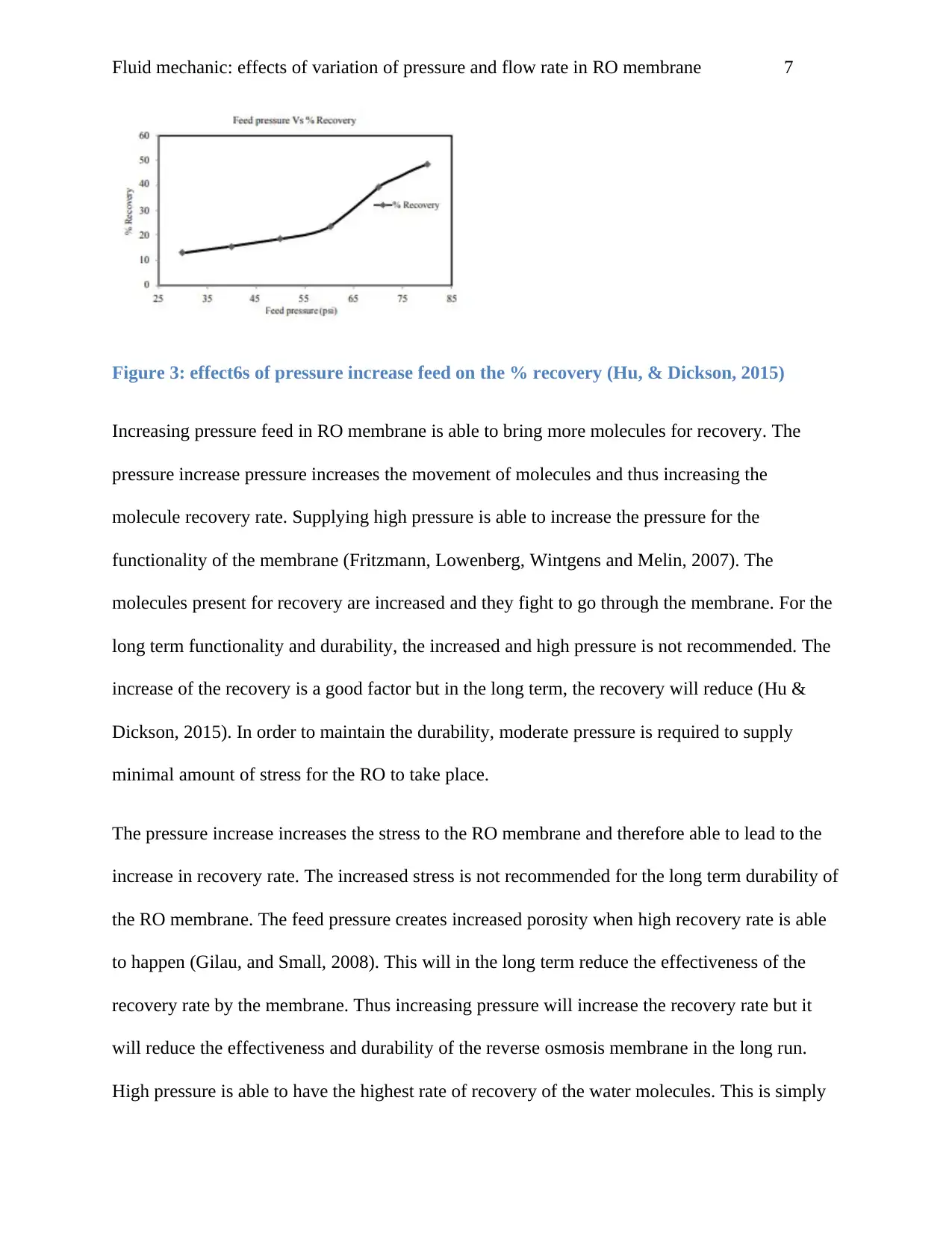
Fluid mechanic: effects of variation of pressure and flow rate in RO membrane 7
Figure 3: effect6s of pressure increase feed on the % recovery (Hu, & Dickson, 2015)
Increasing pressure feed in RO membrane is able to bring more molecules for recovery. The
pressure increase pressure increases the movement of molecules and thus increasing the
molecule recovery rate. Supplying high pressure is able to increase the pressure for the
functionality of the membrane (Fritzmann, Lowenberg, Wintgens and Melin, 2007). The
molecules present for recovery are increased and they fight to go through the membrane. For the
long term functionality and durability, the increased and high pressure is not recommended. The
increase of the recovery is a good factor but in the long term, the recovery will reduce (Hu &
Dickson, 2015). In order to maintain the durability, moderate pressure is required to supply
minimal amount of stress for the RO to take place.
The pressure increase increases the stress to the RO membrane and therefore able to lead to the
increase in recovery rate. The increased stress is not recommended for the long term durability of
the RO membrane. The feed pressure creates increased porosity when high recovery rate is able
to happen (Gilau, and Small, 2008). This will in the long term reduce the effectiveness of the
recovery rate by the membrane. Thus increasing pressure will increase the recovery rate but it
will reduce the effectiveness and durability of the reverse osmosis membrane in the long run.
High pressure is able to have the highest rate of recovery of the water molecules. This is simply
Figure 3: effect6s of pressure increase feed on the % recovery (Hu, & Dickson, 2015)
Increasing pressure feed in RO membrane is able to bring more molecules for recovery. The
pressure increase pressure increases the movement of molecules and thus increasing the
molecule recovery rate. Supplying high pressure is able to increase the pressure for the
functionality of the membrane (Fritzmann, Lowenberg, Wintgens and Melin, 2007). The
molecules present for recovery are increased and they fight to go through the membrane. For the
long term functionality and durability, the increased and high pressure is not recommended. The
increase of the recovery is a good factor but in the long term, the recovery will reduce (Hu &
Dickson, 2015). In order to maintain the durability, moderate pressure is required to supply
minimal amount of stress for the RO to take place.
The pressure increase increases the stress to the RO membrane and therefore able to lead to the
increase in recovery rate. The increased stress is not recommended for the long term durability of
the RO membrane. The feed pressure creates increased porosity when high recovery rate is able
to happen (Gilau, and Small, 2008). This will in the long term reduce the effectiveness of the
recovery rate by the membrane. Thus increasing pressure will increase the recovery rate but it
will reduce the effectiveness and durability of the reverse osmosis membrane in the long run.
High pressure is able to have the highest rate of recovery of the water molecules. This is simply
Paraphrase This Document
Need a fresh take? Get an instant paraphrase of this document with our AI Paraphraser
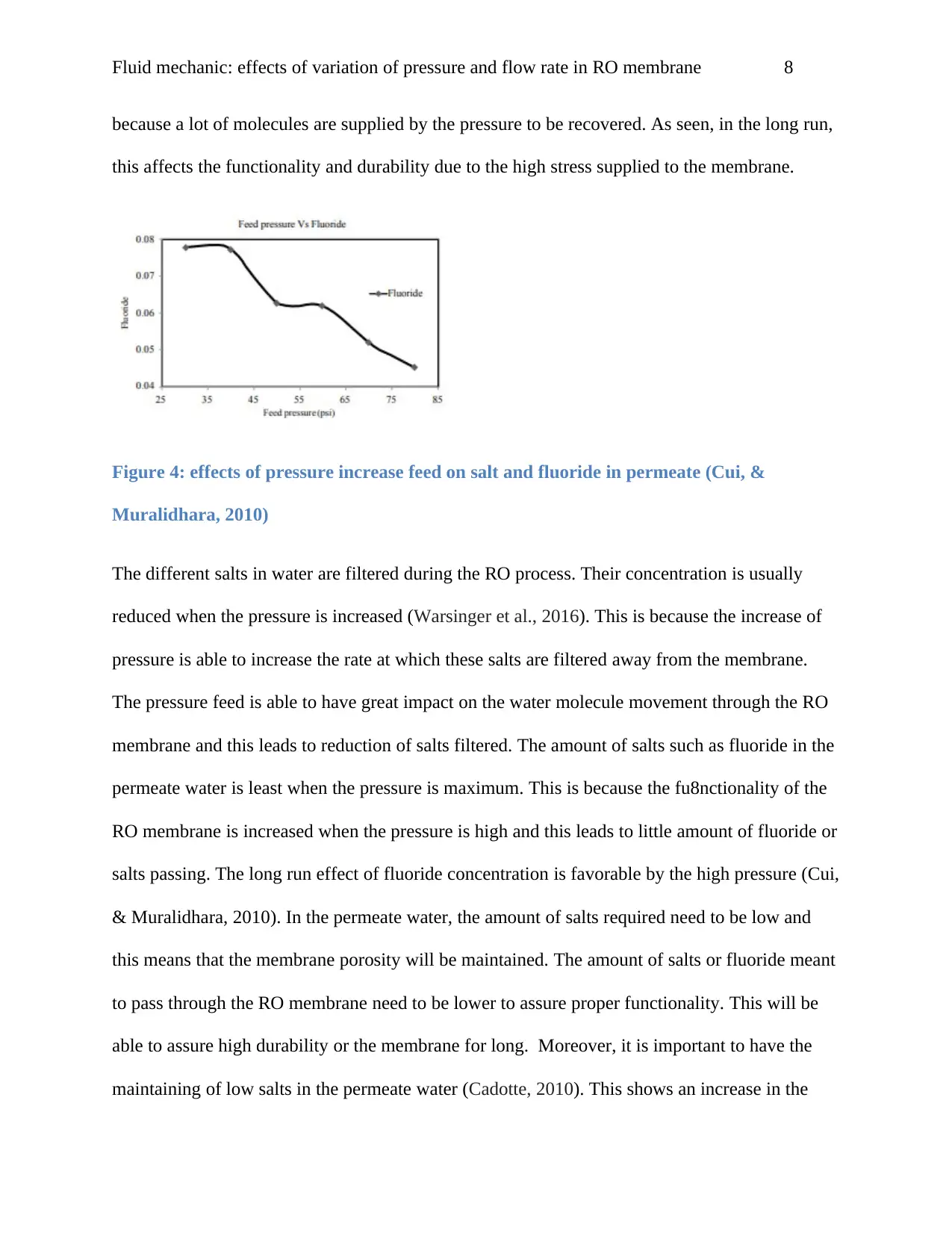
Fluid mechanic: effects of variation of pressure and flow rate in RO membrane 8
because a lot of molecules are supplied by the pressure to be recovered. As seen, in the long run,
this affects the functionality and durability due to the high stress supplied to the membrane.
Figure 4: effects of pressure increase feed on salt and fluoride in permeate (Cui, &
Muralidhara, 2010)
The different salts in water are filtered during the RO process. Their concentration is usually
reduced when the pressure is increased (Warsinger et al., 2016). This is because the increase of
pressure is able to increase the rate at which these salts are filtered away from the membrane.
The pressure feed is able to have great impact on the water molecule movement through the RO
membrane and this leads to reduction of salts filtered. The amount of salts such as fluoride in the
permeate water is least when the pressure is maximum. This is because the fu8nctionality of the
RO membrane is increased when the pressure is high and this leads to little amount of fluoride or
salts passing. The long run effect of fluoride concentration is favorable by the high pressure (Cui,
& Muralidhara, 2010). In the permeate water, the amount of salts required need to be low and
this means that the membrane porosity will be maintained. The amount of salts or fluoride meant
to pass through the RO membrane need to be lower to assure proper functionality. This will be
able to assure high durability or the membrane for long. Moreover, it is important to have the
maintaining of low salts in the permeate water (Cadotte, 2010). This shows an increase in the
because a lot of molecules are supplied by the pressure to be recovered. As seen, in the long run,
this affects the functionality and durability due to the high stress supplied to the membrane.
Figure 4: effects of pressure increase feed on salt and fluoride in permeate (Cui, &
Muralidhara, 2010)
The different salts in water are filtered during the RO process. Their concentration is usually
reduced when the pressure is increased (Warsinger et al., 2016). This is because the increase of
pressure is able to increase the rate at which these salts are filtered away from the membrane.
The pressure feed is able to have great impact on the water molecule movement through the RO
membrane and this leads to reduction of salts filtered. The amount of salts such as fluoride in the
permeate water is least when the pressure is maximum. This is because the fu8nctionality of the
RO membrane is increased when the pressure is high and this leads to little amount of fluoride or
salts passing. The long run effect of fluoride concentration is favorable by the high pressure (Cui,
& Muralidhara, 2010). In the permeate water, the amount of salts required need to be low and
this means that the membrane porosity will be maintained. The amount of salts or fluoride meant
to pass through the RO membrane need to be lower to assure proper functionality. This will be
able to assure high durability or the membrane for long. Moreover, it is important to have the
maintaining of low salts in the permeate water (Cadotte, 2010). This shows an increase in the
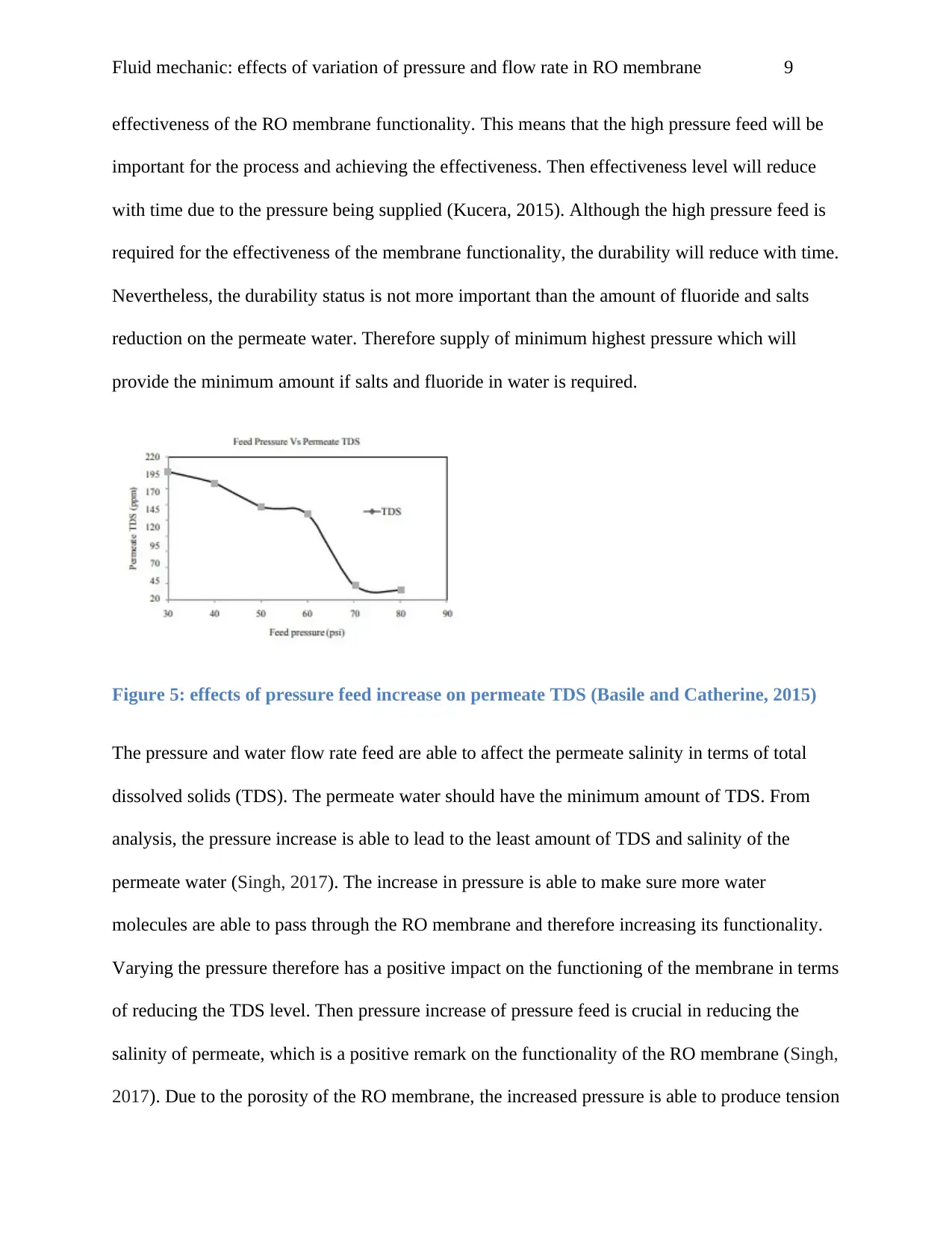
Fluid mechanic: effects of variation of pressure and flow rate in RO membrane 9
effectiveness of the RO membrane functionality. This means that the high pressure feed will be
important for the process and achieving the effectiveness. Then effectiveness level will reduce
with time due to the pressure being supplied (Kucera, 2015). Although the high pressure feed is
required for the effectiveness of the membrane functionality, the durability will reduce with time.
Nevertheless, the durability status is not more important than the amount of fluoride and salts
reduction on the permeate water. Therefore supply of minimum highest pressure which will
provide the minimum amount if salts and fluoride in water is required.
Figure 5: effects of pressure feed increase on permeate TDS (Basile and Catherine, 2015)
The pressure and water flow rate feed are able to affect the permeate salinity in terms of total
dissolved solids (TDS). The permeate water should have the minimum amount of TDS. From
analysis, the pressure increase is able to lead to the least amount of TDS and salinity of the
permeate water (Singh, 2017). The increase in pressure is able to make sure more water
molecules are able to pass through the RO membrane and therefore increasing its functionality.
Varying the pressure therefore has a positive impact on the functioning of the membrane in terms
of reducing the TDS level. Then pressure increase of pressure feed is crucial in reducing the
salinity of permeate, which is a positive remark on the functionality of the RO membrane (Singh,
2017). Due to the porosity of the RO membrane, the increased pressure is able to produce tension
effectiveness of the RO membrane functionality. This means that the high pressure feed will be
important for the process and achieving the effectiveness. Then effectiveness level will reduce
with time due to the pressure being supplied (Kucera, 2015). Although the high pressure feed is
required for the effectiveness of the membrane functionality, the durability will reduce with time.
Nevertheless, the durability status is not more important than the amount of fluoride and salts
reduction on the permeate water. Therefore supply of minimum highest pressure which will
provide the minimum amount if salts and fluoride in water is required.
Figure 5: effects of pressure feed increase on permeate TDS (Basile and Catherine, 2015)
The pressure and water flow rate feed are able to affect the permeate salinity in terms of total
dissolved solids (TDS). The permeate water should have the minimum amount of TDS. From
analysis, the pressure increase is able to lead to the least amount of TDS and salinity of the
permeate water (Singh, 2017). The increase in pressure is able to make sure more water
molecules are able to pass through the RO membrane and therefore increasing its functionality.
Varying the pressure therefore has a positive impact on the functioning of the membrane in terms
of reducing the TDS level. Then pressure increase of pressure feed is crucial in reducing the
salinity of permeate, which is a positive remark on the functionality of the RO membrane (Singh,
2017). Due to the porosity of the RO membrane, the increased pressure is able to produce tension
⊘ This is a preview!⊘
Do you want full access?
Subscribe today to unlock all pages.

Trusted by 1+ million students worldwide
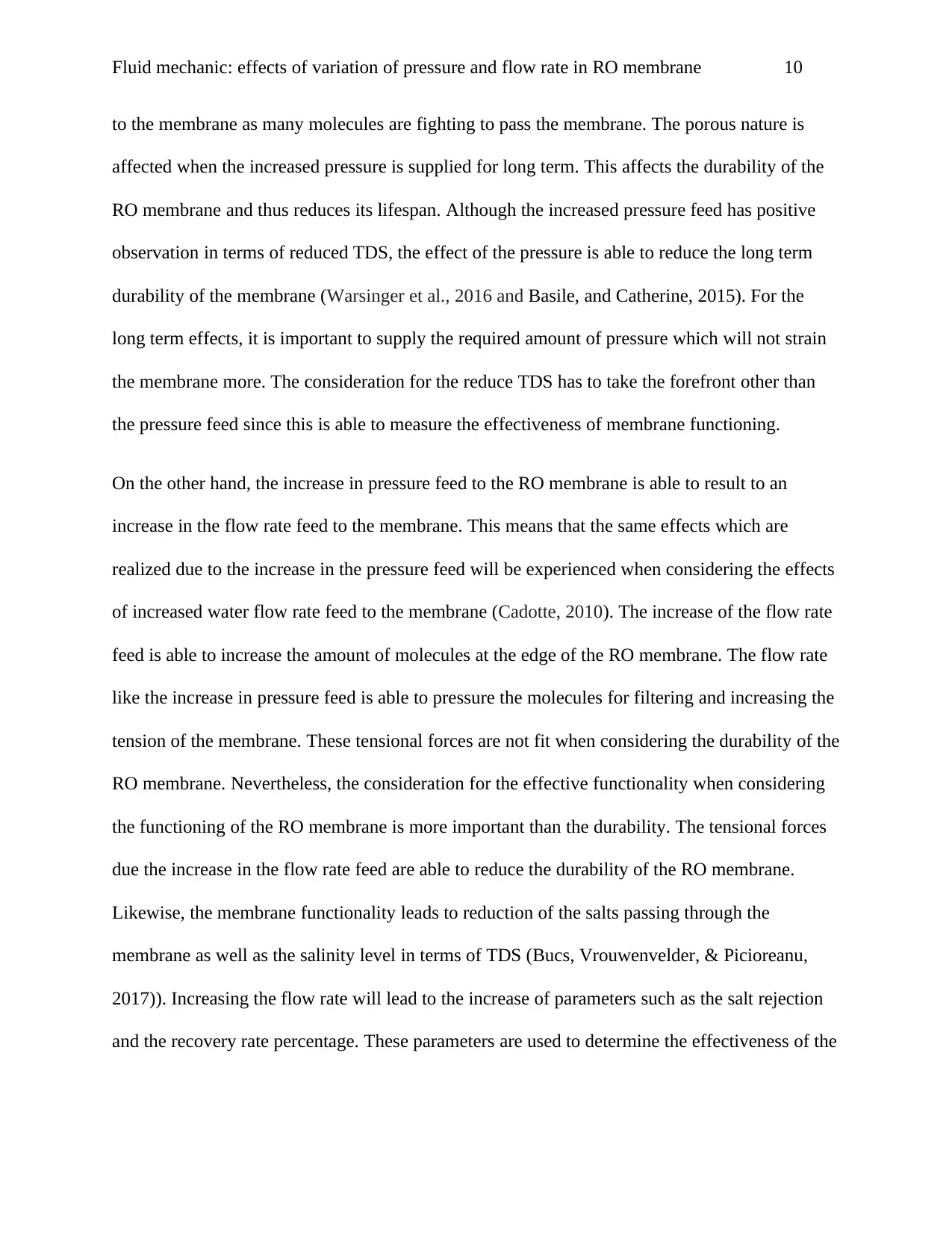
Fluid mechanic: effects of variation of pressure and flow rate in RO membrane 10
to the membrane as many molecules are fighting to pass the membrane. The porous nature is
affected when the increased pressure is supplied for long term. This affects the durability of the
RO membrane and thus reduces its lifespan. Although the increased pressure feed has positive
observation in terms of reduced TDS, the effect of the pressure is able to reduce the long term
durability of the membrane (Warsinger et al., 2016 and Basile, and Catherine, 2015). For the
long term effects, it is important to supply the required amount of pressure which will not strain
the membrane more. The consideration for the reduce TDS has to take the forefront other than
the pressure feed since this is able to measure the effectiveness of membrane functioning.
On the other hand, the increase in pressure feed to the RO membrane is able to result to an
increase in the flow rate feed to the membrane. This means that the same effects which are
realized due to the increase in the pressure feed will be experienced when considering the effects
of increased water flow rate feed to the membrane (Cadotte, 2010). The increase of the flow rate
feed is able to increase the amount of molecules at the edge of the RO membrane. The flow rate
like the increase in pressure feed is able to pressure the molecules for filtering and increasing the
tension of the membrane. These tensional forces are not fit when considering the durability of the
RO membrane. Nevertheless, the consideration for the effective functionality when considering
the functioning of the RO membrane is more important than the durability. The tensional forces
due the increase in the flow rate feed are able to reduce the durability of the RO membrane.
Likewise, the membrane functionality leads to reduction of the salts passing through the
membrane as well as the salinity level in terms of TDS (Bucs, Vrouwenvelder, & Picioreanu,
2017)). Increasing the flow rate will lead to the increase of parameters such as the salt rejection
and the recovery rate percentage. These parameters are used to determine the effectiveness of the
to the membrane as many molecules are fighting to pass the membrane. The porous nature is
affected when the increased pressure is supplied for long term. This affects the durability of the
RO membrane and thus reduces its lifespan. Although the increased pressure feed has positive
observation in terms of reduced TDS, the effect of the pressure is able to reduce the long term
durability of the membrane (Warsinger et al., 2016 and Basile, and Catherine, 2015). For the
long term effects, it is important to supply the required amount of pressure which will not strain
the membrane more. The consideration for the reduce TDS has to take the forefront other than
the pressure feed since this is able to measure the effectiveness of membrane functioning.
On the other hand, the increase in pressure feed to the RO membrane is able to result to an
increase in the flow rate feed to the membrane. This means that the same effects which are
realized due to the increase in the pressure feed will be experienced when considering the effects
of increased water flow rate feed to the membrane (Cadotte, 2010). The increase of the flow rate
feed is able to increase the amount of molecules at the edge of the RO membrane. The flow rate
like the increase in pressure feed is able to pressure the molecules for filtering and increasing the
tension of the membrane. These tensional forces are not fit when considering the durability of the
RO membrane. Nevertheless, the consideration for the effective functionality when considering
the functioning of the RO membrane is more important than the durability. The tensional forces
due the increase in the flow rate feed are able to reduce the durability of the RO membrane.
Likewise, the membrane functionality leads to reduction of the salts passing through the
membrane as well as the salinity level in terms of TDS (Bucs, Vrouwenvelder, & Picioreanu,
2017)). Increasing the flow rate will lead to the increase of parameters such as the salt rejection
and the recovery rate percentage. These parameters are used to determine the effectiveness of the
Paraphrase This Document
Need a fresh take? Get an instant paraphrase of this document with our AI Paraphraser
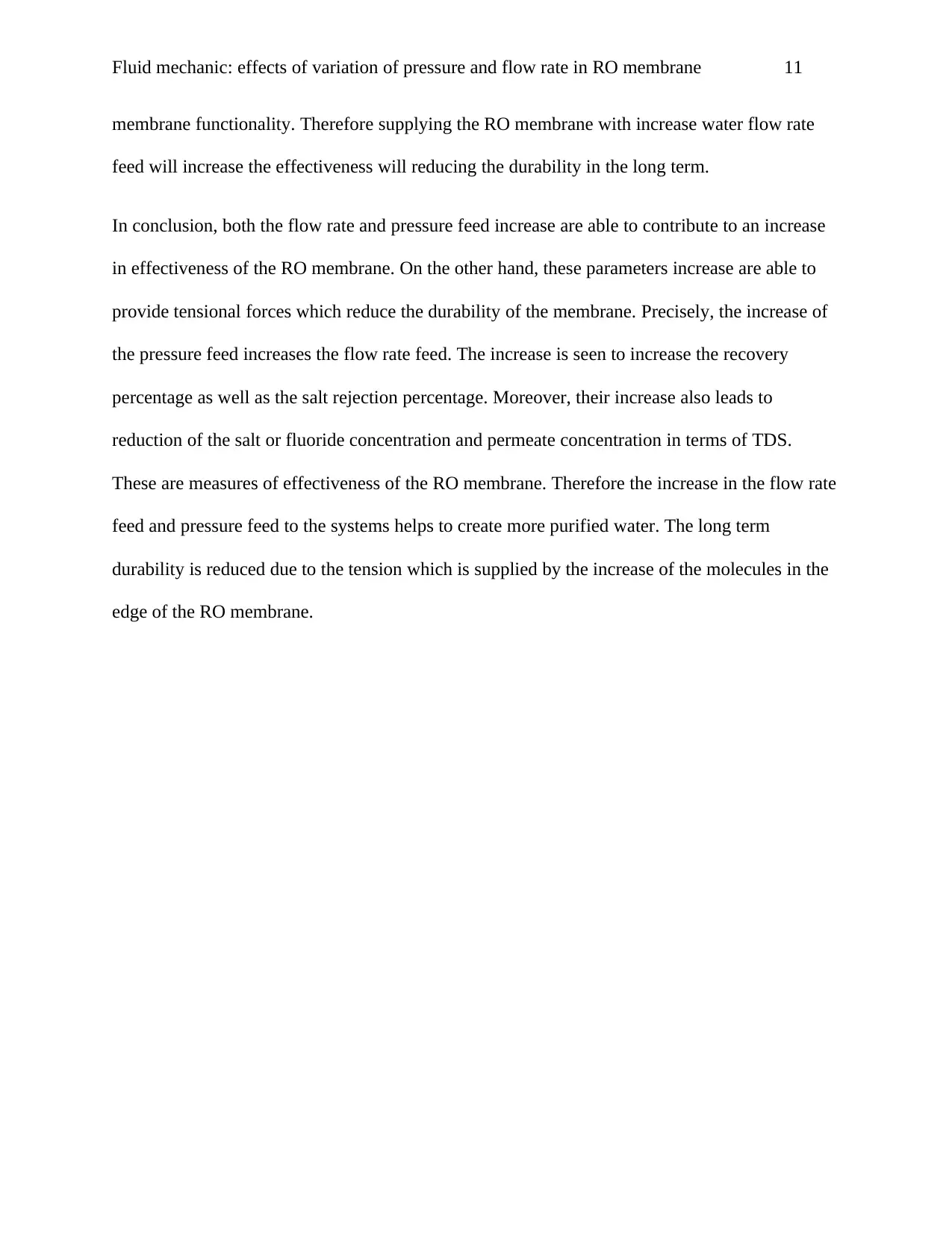
Fluid mechanic: effects of variation of pressure and flow rate in RO membrane 11
membrane functionality. Therefore supplying the RO membrane with increase water flow rate
feed will increase the effectiveness will reducing the durability in the long term.
In conclusion, both the flow rate and pressure feed increase are able to contribute to an increase
in effectiveness of the RO membrane. On the other hand, these parameters increase are able to
provide tensional forces which reduce the durability of the membrane. Precisely, the increase of
the pressure feed increases the flow rate feed. The increase is seen to increase the recovery
percentage as well as the salt rejection percentage. Moreover, their increase also leads to
reduction of the salt or fluoride concentration and permeate concentration in terms of TDS.
These are measures of effectiveness of the RO membrane. Therefore the increase in the flow rate
feed and pressure feed to the systems helps to create more purified water. The long term
durability is reduced due to the tension which is supplied by the increase of the molecules in the
edge of the RO membrane.
membrane functionality. Therefore supplying the RO membrane with increase water flow rate
feed will increase the effectiveness will reducing the durability in the long term.
In conclusion, both the flow rate and pressure feed increase are able to contribute to an increase
in effectiveness of the RO membrane. On the other hand, these parameters increase are able to
provide tensional forces which reduce the durability of the membrane. Precisely, the increase of
the pressure feed increases the flow rate feed. The increase is seen to increase the recovery
percentage as well as the salt rejection percentage. Moreover, their increase also leads to
reduction of the salt or fluoride concentration and permeate concentration in terms of TDS.
These are measures of effectiveness of the RO membrane. Therefore the increase in the flow rate
feed and pressure feed to the systems helps to create more purified water. The long term
durability is reduced due to the tension which is supplied by the increase of the molecules in the
edge of the RO membrane.
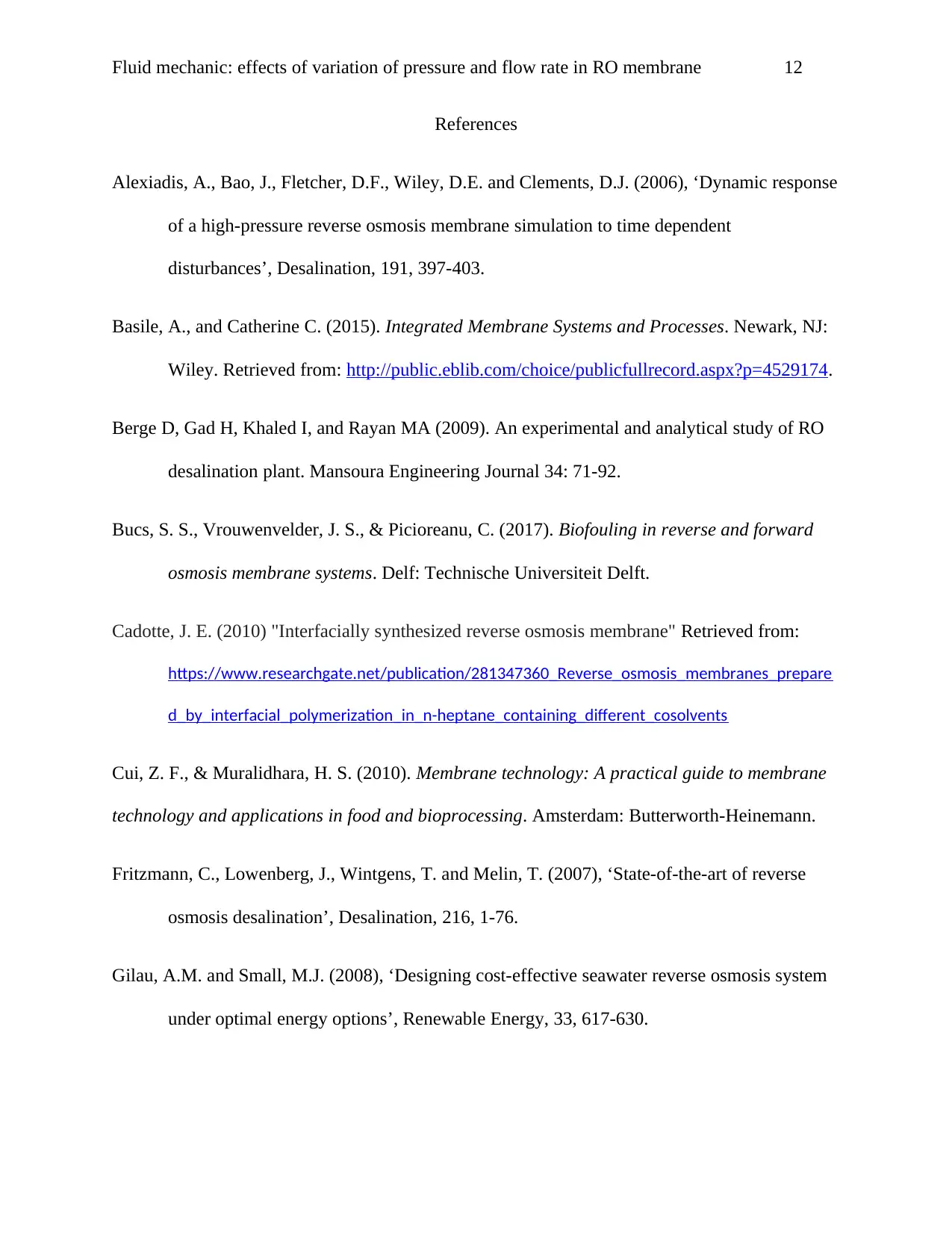
Fluid mechanic: effects of variation of pressure and flow rate in RO membrane 12
References
Alexiadis, A., Bao, J., Fletcher, D.F., Wiley, D.E. and Clements, D.J. (2006), ‘Dynamic response
of a high-pressure reverse osmosis membrane simulation to time dependent
disturbances’, Desalination, 191, 397-403.
Basile, A., and Catherine C. (2015). Integrated Membrane Systems and Processes. Newark, NJ:
Wiley. Retrieved from: http://public.eblib.com/choice/publicfullrecord.aspx?p=4529174.
Berge D, Gad H, Khaled I, and Rayan MA (2009). An experimental and analytical study of RO
desalination plant. Mansoura Engineering Journal 34: 71-92.
Bucs, S. S., Vrouwenvelder, J. S., & Picioreanu, C. (2017). Biofouling in reverse and forward
osmosis membrane systems. Delf: Technische Universiteit Delft.
Cadotte, J. E. (2010) "Interfacially synthesized reverse osmosis membrane" Retrieved from:
https://www.researchgate.net/publication/281347360_Reverse_osmosis_membranes_prepare
d_by_interfacial_polymerization_in_n-heptane_containing_different_cosolvents
Cui, Z. F., & Muralidhara, H. S. (2010). Membrane technology: A practical guide to membrane
technology and applications in food and bioprocessing. Amsterdam: Butterworth-Heinemann.
Fritzmann, C., Lowenberg, J., Wintgens, T. and Melin, T. (2007), ‘State-of-the-art of reverse
osmosis desalination’, Desalination, 216, 1-76.
Gilau, A.M. and Small, M.J. (2008), ‘Designing cost-effective seawater reverse osmosis system
under optimal energy options’, Renewable Energy, 33, 617-630.
References
Alexiadis, A., Bao, J., Fletcher, D.F., Wiley, D.E. and Clements, D.J. (2006), ‘Dynamic response
of a high-pressure reverse osmosis membrane simulation to time dependent
disturbances’, Desalination, 191, 397-403.
Basile, A., and Catherine C. (2015). Integrated Membrane Systems and Processes. Newark, NJ:
Wiley. Retrieved from: http://public.eblib.com/choice/publicfullrecord.aspx?p=4529174.
Berge D, Gad H, Khaled I, and Rayan MA (2009). An experimental and analytical study of RO
desalination plant. Mansoura Engineering Journal 34: 71-92.
Bucs, S. S., Vrouwenvelder, J. S., & Picioreanu, C. (2017). Biofouling in reverse and forward
osmosis membrane systems. Delf: Technische Universiteit Delft.
Cadotte, J. E. (2010) "Interfacially synthesized reverse osmosis membrane" Retrieved from:
https://www.researchgate.net/publication/281347360_Reverse_osmosis_membranes_prepare
d_by_interfacial_polymerization_in_n-heptane_containing_different_cosolvents
Cui, Z. F., & Muralidhara, H. S. (2010). Membrane technology: A practical guide to membrane
technology and applications in food and bioprocessing. Amsterdam: Butterworth-Heinemann.
Fritzmann, C., Lowenberg, J., Wintgens, T. and Melin, T. (2007), ‘State-of-the-art of reverse
osmosis desalination’, Desalination, 216, 1-76.
Gilau, A.M. and Small, M.J. (2008), ‘Designing cost-effective seawater reverse osmosis system
under optimal energy options’, Renewable Energy, 33, 617-630.
⊘ This is a preview!⊘
Do you want full access?
Subscribe today to unlock all pages.

Trusted by 1+ million students worldwide
1 out of 14
Your All-in-One AI-Powered Toolkit for Academic Success.
+13062052269
info@desklib.com
Available 24*7 on WhatsApp / Email
![[object Object]](/_next/static/media/star-bottom.7253800d.svg)
Unlock your academic potential
Copyright © 2020–2025 A2Z Services. All Rights Reserved. Developed and managed by ZUCOL.
